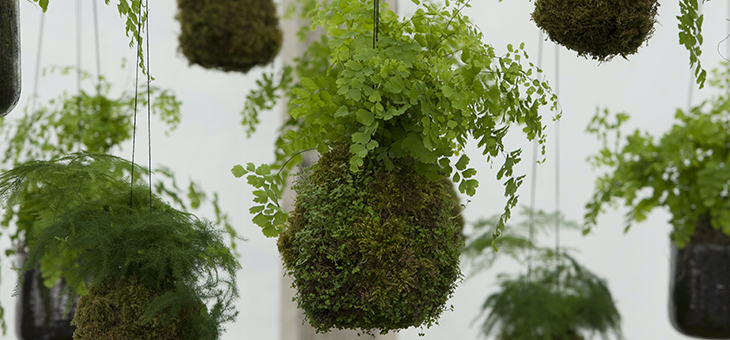There’s been a buzz around the Japanese art of kokedama in the past few years with terrific displays at major flower shows.
Never heard of it? Originating in 17th century Japan and derived from the ancient art of bonsai, kokedama translated means ‘moss ball’.
The art generally involves removing a root system and plant from its container, wrapping the roots in a ball of wet compost, and enveloping the whole soggy mess in a ball of moss, before tying it up with string. You then suspend it, so the leaves dangle over the edge of the moss, in a sort of alternative Japanese hanging basket.
“The Japanese don’t have very much space, so if you’ve got everything suspended and hanging down, you can create a really lovely display,” explains florist, planting designer and author Carolyn Dunster, who created an eye-catching kokedama display at the Royal Horticultural Society UK Malvern Spring Festival in the past.
As for which plants are suitable for the method, Ms Dunster prefers ferns and plants that suit a woodland setting, but you could just as easily create festive kokedamas with poinsettias, Christmas cacti and colourful azaleas for the festive season. “I used poinsettias last year and they looked really cool, because the colour of the poinsettia against the dark green of the moss worked really well,” says Ms Dunster. “Or, at Christmas, you could use ivy with some fairy lights threaded through it. But out of everything I’ve experimented with, ferns seem to be the plants that adapt best to the kokedama treatment.”
Don’t put more than one plant in a kokedama, or they might struggle. Use plants that don’t have huge root balls, and which don’t want to expand too much. Christmas cacti and most houseplants also lend themselves well to kokedama. If you’re wrapping them in moss, use plants that fit into that environment.
“I don’t like plants that look too designed. I like things to look natural. You are bringing nature inside. Little bulbs like narcissus paperwhites look lovely, or little Muscari bulbs or anything which fits into a woodland setting,” Ms Dunster notes.
Keen to give kokedama a try? Here’s Carolyn Dunster’s step-by-step guide.
1. What you’ll need
You’ll need a suitable plant, florists’ wire, string, secateurs and wire cutters, a piece of hessian and some sheet moss, plus a mister for misting the plant and moss at the end.
2. Form a root ball and wrap it up
Remove the plant from its pot, water it so it’s moist, and then mould the compost surrounding the roots into a ball. Wrap the root ball in a little bit of hessian, securing it with string or a piece of florist wire. The hessian will keep the compost in place.
3. Use string and wire for hanging
Using string and florists’ wire, make a loop from which you can hang the kokedama. Tie the string to two pieces of wire and attach them to the hessian on both sides.
4. Roll out your moss
“I think it’s best to use sheet moss, which you can get from most florists. It’s moss that’s more knitted together, so bits aren’t going to drop off. You can use sphagnum moss, but you have to bind that in,” Ms Dunster advises.
Sheet moss is harvested from woodland areas and comes in big pieces. Roll the moss out with a rolling pin before wrapping it around the hessian, trying to keep it intact so the moss remains in one piece.
5. Secure it with florists’ wire
Once you’ve secured the moss around the root ball with florists’ wire, trim the overlapping excess with sharp scissors. You can then put it on a table in a saucer, or fashion it so that it’s suspended with some bits of wire or string.
6. Don’t overdo the watering
“You only need to mist the kokedama every now and again. If it starts to dry out, sit the whole thing in a bucket of water overnight. They’re not difficult to look after. You just have to keep an eye on them,” says Ms Dunster.
Depending on the plants you use, some kokedama can be taken outside to create a display.
7. Finally – find the perfect setting
“If you have the space, a display of suspended kokedama looks lovely, in a hallway or a room where they can take centre stage,” says Ms Dunster. “Have them at slightly different heights – so if you have three or five at different heights then you get the real effect of what they were originally used for, which was the Japanese string garden. It’s how to create an indoor hanging garden.”
Have you seen these before? Will you be giving it a try or do you prefer houseplants in traditional pots?
– With PA
If you enjoy our content, don’t keep it to yourself. Share our free eNews with your friends and encourage them to sign up.
Related articles:
https://www.yourlifechoices.com.au/lifestyle/leisure/creating-a-garden-when-space-is-limited
https://www.yourlifechoices.com.au/food-recipes/food/growing-vegies-in-containers
https://www.yourlifechoices.com.au/lifestyle/house-plants-that-remove-toxins

